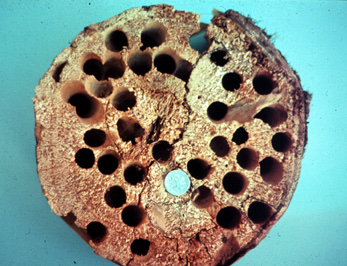
Solitary and Social Bees
Grades: 4-6
Essential Skills: Language Arts, Science
Duration: 1 class period
OVERVIEW
At the end of the lesson the students should be able to name at least four kinds of bees, name the two major life-styles (solitary and social), and describe or draw a life cycle of the day in the life of a bee.
Preparation
Curriculum Support Materials:
Information Sheets:
Lesson Plan
Introduction activity (30 minutes)
Review Information Sheet 1, Bee Basics. Using Information Sheets 20 (ID Tips) and 21 (Solitary Bees) and Poster 4 as references, introduce students to the different types of bees and their day-to-day activities. Lead a discussion about what a day in the life of each type of bee would be like. For example, a carpenter bee must build a nest in a stump or log, wheras a leafcutter bee stuffs pieces of leaf into holes and hollow stems that are already in place. Have the students research the different types of bees.

Have the students make up lists of things (behaviors) that solitary bees do every day. Have the students discuss and compare the jobs performed by solitary bees with those of the highly social honey bee. For example, a female solitary bee never takes care of her own larvae because she is often dead before some or all of the larvae hatch from eggs. However, she must build and provision her nest completely on her own, without any help from other bees. What are the advantages of being solitary? What are the advantages of being social?

Activity 2 Building a bee house (45 minutes)
Not everyone realizes it, but solitary bees are important for pollination, especially for native plants. And they are less likely to sting than social bees. To encourage solitary bees, provide a suitable place to nest. You can purchase ready-made orchard bee houses (see Information Sheet 29) or make your own leafcutter bee house. Note: these houses will NOT attract Africanized honey bees, or any type of social bee.
To make leafcutter bee houses, paint clean tin cans to prevent rusting or tarnishing. Use your imagination to decorate the cans, if so desired. Have the students cut large paper straws to lengths about half an inch shorter than the can. Push a bundle of straws into the can with the open ends out, until the can is filled. Attach a hanger to the can so the bee home can be hung on a fence or in a tree in the spring because that's when the bees are active (not in the fall) . Encourage the students to place the nests where younger children or animals can't disturb them.
You may want to hang out some nests yourself, so you can slice open a straw and show your students what a solitary bee nest looks like.
Conclusion Discussion questions (30 minutes)
How are bees different from wasps?
Bees are robust, hairy insects. They may have special structures such as pollen baskets on their legs to carry pollen. They only feed on pollen and nectar (with the exception of vulture bees, which do eat meat). Wasps are shiny with a narrow waist, and are largely carnivorous (they feed on other insects, arthropods, and even carcasses in some cases.) Show Poster 4.
Why are bees of primary importance to us?
Bees pollinate crops that result in about a third of the food we eat.
Why else are bees important to people?
Honey bees produce honey and beeswax. Some people use bees and bee products for health reasons. Royal jelly and bee pollen are available from health food stores. Bee stings are used in apitherapy for arthritis and multiple sclerosis treatments
How are solitary bees different from social bees? How are they similar? Would you rather be a solitary bee or a social bee and why?
See Information Sheet 21 for answers.
How many kinds of bees are there?
See Information Sheet 1 for answers.
Why are there so many kinds of bees?
Different kinds of bees collect pollen from different kinds of flowers. For example alkali or leafcutter bees are used to pollinate alfalfa plants because honey bees don't like alfalfa flowers.
Additions
Words with special meanings:
(for understanding only, not to be tested)
Bibliography:
The Bee, by B.B., Norden. Published by Stewart, Tabori & Chang, New York, 1991.
Discovering Bees and Wasps, by C. O'Toole. Published by the Bookwright Press, NY, 1986.
Bees of the World, by C. O'Toole and A. Raw. Published by Blandford Publ., London, 1991.
Bees and Wasps, by K. Petty. Published by Gloucester Press, NY, 1987.
Bees and Wasps, by H. Pluckrose. Published by Franklin Watts, Inc., NY. 1987.
Also see the "Focus on Nature" column in
Arizona Highways. For example in the June 1993 issue, J.
Alcock wrote 'Carpenter Bees: Building for the Next Generation'. (pp. 38-39).
Return to homepage